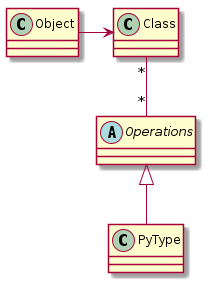4.1. Introduction¶
Here we will test the idea that we may treat any Java object
as a Python object,
starting afresh on a third model run-time system
in sub-project rt3.
4.1.1. Motivations¶
Our primary emphasis has been, and remains, whether a viable Python interpreter may be made in Java, following the patterns we have chosen to explore. These patterns are intended to engage the Java features that support dynamic language implementation. We have avoided doing much to optimise performance in detail. However, our interest in exploring particular patterns and using those features effectively is driven ultimately by the performance they offer.
The particular concerns in the rt3 sub-project are:
Use of
java.lang.Objectin place ofPyObject. Guidance supporting the launch ofinvokedynamicwas to use Java types rather than create a base type for the language.Smooth integration with Java. Insisting on a
PyObjectbase or interface for everyobjectnecessitates a proxy for any object that isn’t aPyObject, which adds indirection to calls and complexity in handling identity.To allow multiple implementations of a single Python type. For example we might want BMP and full Unicode implementations of the
strtype, that are indistinguishable to Python.To adopt certain Java types as implementations of built-in Python types. For example a
java.lang.Integeris adopted as a Pythonint. This is in the expectation that the JVM will optimise code best when we use its native boxed types, perhaps even un-box them when it can.
Concepts developed in sub-project rt2 will be heavily re-used.
These include:
Sub-classes of
PyCodeandPyFrameto support different types of code (e.g. CPython byte code).A CPython byte code interpreter.
Mechanisms for functions defined in Python.
Numerous support and abstract API methods already coded.
Exposure through annotations leading to descriptors with method and variable handles.
SlotandSignatureas the source of tailored descriptors and method handles.
4.1.2. Design Concept¶
To the ideas tested in rt2,
we add a new concept: the Operations object.
(It has been brewing a while.
It may even be seen as revisiting an idea present in rt1.)
The Operations object contains the information specific to a Java class,
that allows the run-time system
to treat an instance of the class as a Python object.
This includes identification of a Python type object for the instance.
Some responsibilities that in rt2 belonged to PyType,
now belong to Operations.

Plain Java Object Pattern¶
The relationship of a java.lang.Class to its Operations object
is implemented by a ClassValue.
The relationship of PyType to Operations,
is technically many-to-many,
but actual multiplicities amongst these objects
depends on the general type of class being described.
We shall explore in the necessary sub-classes
and patterns that arise
in subsequent sections.
We think of the Operations object primarily as
the means by which we will generate targets and guards
for CallSite objects bound to invokedynamic instructions.
We shall still approach the topic initially via CPython byte code,
but code fragments in which a CallSite appears
will be increasingly significant.
4.1.3. Feasibility¶
We can see by inspection that much of the rt2 code
will probably work in the new concept:
rt2 handles objects generically as PyObject (an interface),
and the only method of in that interface is getType().
If we can find a substitute for that single method,
we may switch from PyObject to Object in the code,
and the interpreter (or compiled code)
will begin to handle the java.lang.Object directly.
However, at the time of beginning exploration in rt3,
it is not at all certain that such an approach has the benefits hoped for.